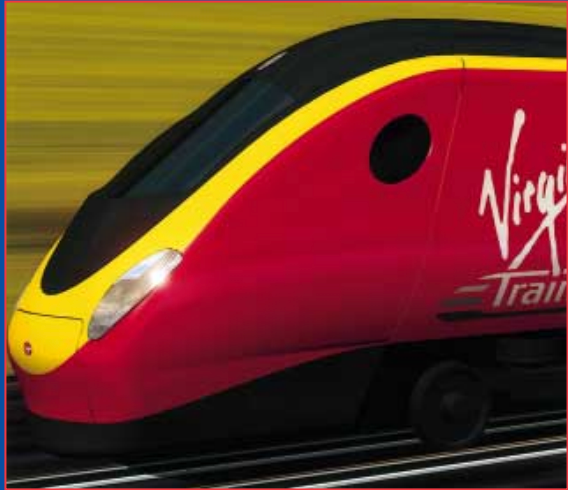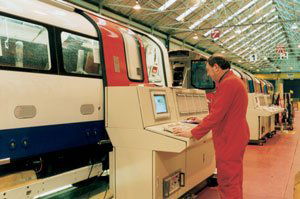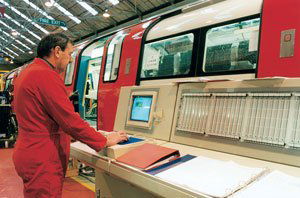
Returning publicly owned enterprises to the private sector is a process known as privatisation. The effects of privatisation are highly significant as organisations, which have previously enjoyed monopoly control of their industry, have to respond to customer needs, market forces and competitive pressures.
Privatisation of the railway industry created the opportunity for organisations seeking growth to operate proactively in order to meet increasingly high customer expectations. Managers were able to make completely different decisions from those of the past in order to develop new products and construct deals to meet different criteria. At the heart of this process is strategic planning. This involves deciding on objectives and priorities for an organisation, in order to realise a vision. In this case, the aim is to construct and finance a project which produces the right combination of new products and technologies to satisfy rail users and which, at the same time, meets the expectations of shareholders.
This case study focuses on the largest post-privatisation challenge – the West Coast Main Line (WCML). It describes how risk management has helped ALSTOM, the global transport group, to supply a fleet of high speed tilting trains, maintenance and associated services for this route.

The West Coast challenge
Linking London with the West Midlands, North West England and Scotland, the WCML has traditionally been Britain’s busiest business route. Inspite of this pivotal role to Britain’s transport infrastructure, it has suffered from under-investment for more than 20 years.
In 1966, electrification of the route between London and Liverpool/ Manchester created Britain’s first high speed railway. Eight years later, electrification through to Glasgow was completed, reducing time for the 650km journey to five hours. Although
plans existed to upgrade the route, the WCML stagnated, while other main lines in Britain continued to develop during the 1980s. Privatisation of British Rail was seen as an opportunity to turn the WCML into a modern high speed railway.
The vision is to make the West Coast Main Line the UK’s premier railway line. When the upgrading is completed, tilting trains will travel at 140 miles per hour. Birmingham will be just an hour and a quarter from London; Manchester one and three
quarter hours; and Glasgow under four hours. New technology will enable trains to offer increased standards of safety, service and comfort and the upgraded lines will carry double the present number of high speed trains.
Upgrading railways incurs enormous capital costs and has, for more than 50 years been financed through the public purse. Modernisation of Railtrack’s WCML is the largest rail project in Britain today. Upgrading the track and signalling for higher
speed and more capacity will cost £2.1 billion, with a new fleet of 225 km/h high speed tilting trains for the route costing £500 million.
This massive upgrade is dependent on the ability of the partnership between ALSTOM, Railtrack and the train operator, Virgin West Coast, to develop a completely different approach to financing a project from the private sector. ALSTOM’s role is critical in
this partnership. In addition to supplying the radio signalling equipment and tilting trains, ALSTOM companies will also be responsible for other infrastructure upgrades and a range of maintenance tasks.
ALSTOM
ALSTOM provides a comprehensive range of design, manufacturing, operating and maintenance services for the rail transport industry. Within the ALSTOM Group, ALSTOM Transport Ltd (formerly Metro-Cammell) and ALSTOM Train Services are UK based specialist train manufacturers and maintainers, and ALSTOM’s Signalling Business is Europe’s leading railway signalling company, with operational centres along the West Coast Main Line.
Working under British Rail
Before privatisation, the Government dictated contracts for new rail projects and British Rail would design the complex technical specifications for trains that determined all performance features. The two main specialist train manufacturers in the UK shared investment for new trains. As British Rail was the only operator, new vehicles were engineering-led based on product orientation. A key feature of production orientation is monopoly power – when monopolies exist, there is less need to improve products.
After taking delivery of a train, British Rail would specify a short period of warranty from the supplier of approximately two years. British Rail would then maintain and overhaul the trains, in addition to providing rail and transport services, such as station facilities, ticketing for passengers and railway infrastructure maintenance. ALSTOM was therefore denied the opportunity of developing business in the aftermarket. As a result, train manufacturers, such as ALSTOM, relied solely on large contracts for building trains and suffered from either feast or famine, i.e. they were either snowed under with orders or had to cut back as orders declined. Building trains was a stop/start industry and because each order was different, there were high capital costs and no retained technology.
Privatisation
Privatisation of the rail industry provided a fresh opportunity to turn the West Coast Main Line into a modern, high speed railway, driven by market based consumer needs and requirements. By May 1997, all 25 train operating companies were privatised and supported by rolling stock companies and Railtrack. Although privatisation was essentially a political strategy, it created opportunities for new-build investment with the assurance of funding that governments had previously been unable to provide.
The key change in this new market structure was that, for the first time, the companies operating the trains were not directly involved with how trains were designed and built. This meant that when considering the requirements for new vehicles, the train operating companies would want to provide a performance specification and not, as British Rail had done a technical specification. For the first time, ALSTOM was able to:
- design its own trains
- get involved in after-market opportunities to support its rolling stock.
As a result of privatisation and within a short period of time, more than £3 billion of new rolling stock is being procured with investment also taking place by Railtrack in the new railway infrastructure.
Risk and return
In the newly-formed private sector, bidding for contracts to provide rolling stock and railway services depends on risk and reward. Although ALSTOM has a large market share and considerable experience in the industry, each tender it makes varies according to train specifications, maintenance agreements, provision of spares and financing. This, therefore, places more emphasis on managers to assess carefully whether each project is worth the risk and what the associated rewards are likely to be.

In order to manage risk, ALSTOM has pioneered a critical change in focus for train builders by moving from being simply a train builder to a service provider. By the late 1980s, passenger vehicles were becoming complex systems, incorporating an increasing amount of high value equipment from specialist suppliers. It was realised at ALSTOM that, although these more complex trains were an opportunity to improve the quality of the product, the risk of non-performance or late delivery had increased. The key was to integrate the work of specialist suppliers so that such risk could be successfully managed.
Privatisation has meant that risks have been taken away from the Government and transferred to the private sector. For example, under the Private Finance Initiative (PFI), ALSTOM successfully bid to provide trains and services for London Underground’s Northern Line. ALSTOM’s bid was to take the asset risk by providing trains for the line for twenty years, with the Government paying ALSTOM for the performance of each asset. This involved building 636 new vehicles, with full maintenance for the next 20 to 36 years and running 85 trains each day that meet journey times. Penalties are imposed if trains do not meet deadlines and bonuses are added if they do – so it is vital that the trains are reliable.
As ALSTOM now has a contract to supply trains for the Northern Line for a period of twenty years, it can no longer think only of the cost of building trains. It must consider the long-term cost of the asset. It is, therefore, in ALSTOM’s interest to keep trains in pristine condition and improve them during their lifetime as this reduces maintenance costs and earns more bonuses.
The Northern Line project provided ALSTOM with key experience – not just in constructing projects but also in financing them. By taking the asset risk for the project, ALSTOM extended its role as a train manufacturer to act as a rolling stock company. ALSTOM then went to the financial markets to provide the funds for building the trains with financiers who took the financial risk for the project.

The West Coast Main Line project
In order to provide services for the next twelve years, ALSTOM had to create a structure which would work with Railtrack, the train operating company owned by the Virgin Group, and the rolling stock companies with leases on the existing fleets. To provide the train operating company with services for 48 fully maintained trains a day, ALSTOM has taken over the responsibility for six maintenance depots and more than 700 staff.
The first phase of the Passenger Upgrade (PUG1) involves strengthening the electrical power supply and laying a higher quality track to accommodate trains which can operate at 200 km/h. To meet Virgin’s aspirations for the route, Railtrack will then upgrade the infrastructure further (PUG2) to make the first track in the world to feature 225 km/h running on the existing alignment. ALSTOM bought into the Virgin vision by forming an alliance with Fiat Ferroviaria of Italy to build trains with advanced tilt technology to meet the requirements of the Virgin plan. ALSTOM/Fiat is to supply 54 eight-car trains worth around £500 million, with all of the components coming together at the ALSTOM plant in Birmingham, where the new train was first conceived and designed.
To meet its franchise plan, Virgin needs the new trains to start earning money as early and as quickly as possible. The first train is due to roll out early in 2001 and production is scheduled to run at four trains a month so that all 54 are available for service when PUG1 is completed, allowing 200 km/h running from the end of May 2002.
Managing risk
ALSTOM’s role is to build and maintain trains until the end of the period of Virgin’s franchise in 2012. It is also hoped that they can continue to maintain the trains after the franchise. The financiers of the Northern Line project did not take out asset risk. However, the financiers for the WCML project, representing banks and other financial institutions, are taking releasing risks after 2012, beyond the date of the first franchise. Up to 2012, financiers have a guaranteed income stream from the project. The risk comes after 2012 – will the income generated for the rest of the lifetime of the asset be sufficient to fund the financing structure and generate a profit on the investment in new trains? It is the financiers, having made the building of the trains possible, who take the credit risk of supplying trains for Virgin.
For the financier, the asset sits on their balance sheet and is a finance lease. A rate of interest is charged for the money used to buy the asset. The risk is simply the credit rating of the operating company and its ability to pay the rate of interest in the form of a rental payment. The operating lease between the asset manager and Virgin is only for the period of the asset covered by the franchise. At the end of the period of the franchise, income has to be found from re-leasing the asset to Virgin or other train operators who may not operate on the West Coast Main Line.
Joint venture
The West Coast Main Line project to build and maintain trains is a joint venture between ALSTOM and Fiat Ferroviaria. The mission is to provide Virgin, every day and on time, with a set of new, reliable trains to meet the timetabled need. To achieve this mission, the partnership takes responsibility for five key areas
including:
- a new fleet of high speed tilting trains
- a delivery programme
- maintenance and customer support
- performance guarantees
- safety case and vehicle acceptance.
The belief is that the total package will not only ensure the delivery to Virgin (and its customers) of high quality trains, at the right place and the right time but also with the right level of service provision.
The signalling challenge

High speed trains demand high safety standards. Passengers need to have the reassurance that signalling will incorporate fail-safe measures that can override any human error. The European Commission has introduced important common standards across European railways through funding of European Rail Traffic Management System (ERTMS) projects to help perfect a uniform signalling system.
The contract for the Train Control System for the West Coast Main Line, based on work with ERTMS, established ALSTOM as the clear leader in this field. Added to the challenge is the fact that the WCML is a high density railway which will carry traffic ranging from freight and commuter trains to Virgin’s 225 km/h tilting fleet. The project uses state-of-the- art transmission-based signalling technology and will be Europe’s biggest-ever signalling contract. Each train journey will be pre-programmed into the management centre computers, indicating priority starting times, speed restrictions and station stop to maximise capacity on the route. Dedicated digital telecommunications links and electronic controls keep the route’s management centres in touch with trains via lineside radio stations. The system will keep drivers and the network controllers in constant touch – ensuring fewer delays for passengers.
In its winning bid, ALSTOM was also supported by Siemens and Alcatel of Germany. Siemens in the United Kingdom has experience of switching technology for the digital radio, which provides the link between the signalling equipment and the train cab, and Alcatel is a specialist in odometry – the precise measurement of the distance a train has travelled since the last reference point.
Conclusion
This case study highlights some of the changes that have taken place since railway privatisation and its effect on organisations providing services within the railway industry. The West Coast Main Line modernisation emphasises the capability of organisations in the railway industry to respond to this challenge to source the finance and manage the risk through large investment contracts so that markets for rail travel can be further developed. Valued at more than £1 billion, the new trains built and maintained by ALSTOM have become the centrepiece of Virgin’s plans to form the backbone of its franchising commitment to its customers.
